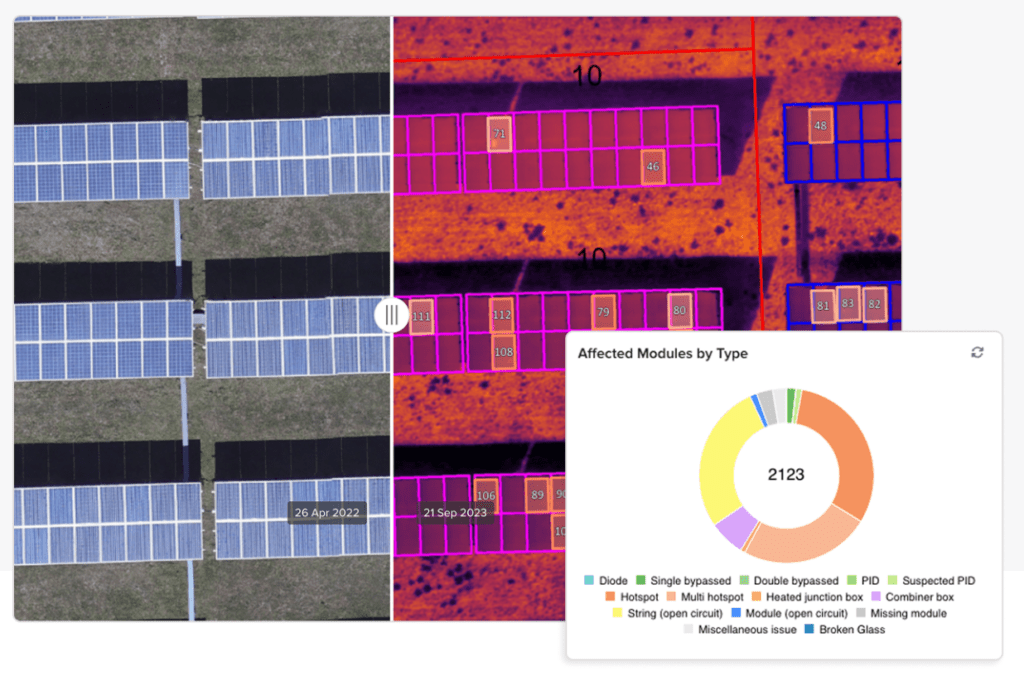
We’ve been busy with our friends at Sitemark, doing lots of solar farm thermography in NSW and QLD.
Solar farm thermography using drones is a critical tool for the maintenance, efficiency, and longevity of solar energy systems. Here are several reasons why it is so important:
1. Early Detection of Faults and Defects
-
Hot Spots and Malfunctions: Drones equipped with thermal cameras can detect hot spots on solar panels, which are often indicative of malfunctioning cells, faulty wiring, or other issues. Early detection allows for timely repairs, preventing further damage and energy loss.
-
Microcracks and Cell Defects: Thermal imaging can reveal microcracks or defects in solar cells that are not visible to the naked eye. These defects can reduce the efficiency of the panel over time.
2. Improved Efficiency and Performance
-
Optimizing Energy Output: By identifying underperforming panels or sections of the solar farm, operators can take corrective actions to ensure that the entire system is operating at peak efficiency.
-
Reducing Downtime: Regular thermographic inspections help in scheduling maintenance activities proactively, reducing the likelihood of unexpected downtime.
3. Cost-Effective Maintenance
-
Reduced Labor Costs: Traditional inspection methods often require manual labor, which can be time-consuming and expensive. Drones can cover large areas quickly and efficiently, reducing the need for extensive manpower.
-
Minimized Operational Disruptions: Drones can perform inspections without the need to shut down the solar farm, minimizing disruptions to energy production.
4. Enhanced Safety
-
Reduced Risk to Personnel: Inspecting solar panels, especially in large solar farms, can be hazardous for personnel due to the height and scale of the installations. Drones eliminate the need for workers to physically access the panels, thereby reducing the risk of accidents.
-
Access to Difficult Areas: Drones can easily access hard-to-reach areas, such as rooftops or uneven terrain, where manual inspections would be challenging or dangerous.
5. Comprehensive Data Collection
-
High-Resolution Imaging: Drones can capture high-resolution thermal images, providing detailed insights into the condition of each panel.
-
Historical Data Comparison: Regular drone inspections allow for the collection of historical data, which can be used to track the performance and degradation of panels over time. This data is invaluable for predictive maintenance and long-term planning.
6. Scalability
-
Large-Scale Inspections: Drones are particularly useful for large solar farms, where manual inspections would be impractical due to the sheer size of the installation. They can cover vast areas in a relatively short amount of time.
-
Flexibility: Drones can be deployed quickly and can adapt to different types of solar installations, whether they are ground-mounted, rooftop, or floating solar farms.
7. Environmental Benefits
-
Reduced Carbon Footprint: By optimizing the performance of solar panels, drone thermography helps in maximizing the energy output, thereby contributing to a reduction in the carbon footprint of the energy production process.
-
Sustainable Maintenance Practices: Drones themselves are often powered by batteries, making them a more environmentally friendly option compared to traditional inspection methods that may rely on fossil fuels.
8. Regulatory Compliance and Reporting
-
Meeting Standards: Regular thermographic inspections can help solar farm operators comply with industry standards and regulations, ensuring that the installation is operating safely and efficiently.
-
Detailed Reporting: The data collected by drones can be used to generate detailed reports for stakeholders, insurers, and regulatory bodies, providing transparency and accountability.
9. Future-Proofing
-
Integration with AI and Machine Learning: The data collected by drones can be integrated with AI and machine learning algorithms to predict future failures and optimize maintenance schedules. This proactive approach can significantly extend the lifespan of the solar farm.
In summary, solar farm thermography using drones is a powerful tool that enhances the efficiency, safety, and sustainability of solar energy systems. It allows for early detection of issues, reduces maintenance costs, and provides comprehensive data that can be used for long-term planning and optimization. As the solar industry continues to grow, the importance of drone-based thermography is likely to increase, making it an indispensable part of solar farm management.
